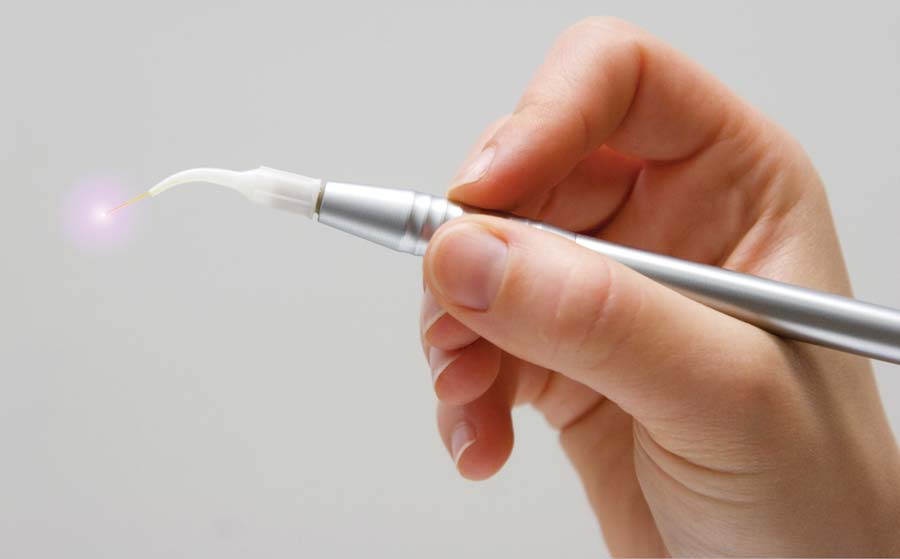Minimally Invasive Dentistry
When Less Care Is More
(Continued)
Minimally Invasive Treatment
If teeth are past the point of prevention or remineralization but dental decay is still in its relatively early stages, various conservative methods to reverse or treat the damage can be applied with MID.
The process of decay starts when acids actually dissolve or "demineralize" the sub-surface enamel. At this early stage, tooth surfaces can be "remineralized" by saliva and its natural buffering (neutralizing) capacity, particularly in the presence of fluoride, which not only remineralizes the enamel but makes it more resistant to further acid atack.
Agents such as chlorhexidine (a prescription anti-bacterial rinse), reduce decay-causing bacteria. Topical fluorides (applied to the tooth surfaces) encourage remineralization and CPP-ACP,* a milk-derived product, increases the availability of fluoride for remineralization.
If teeth are past the point of prevention or remineralization but dental decay is still in its relatively early stages, various conservative methods to reverse or treat the damage can be applied with MID.
Newer MID Treatment Techniques
Air Abrasion is a technique that uses fine particles of aluminum oxide, glass beads or a baking soda mixture in a powerful air stream aimed at the decayed portion of the tooth. Compared to the drill, air abrasion leaves more of the healthy tooth tissue intact and sometimes eliminates the need for anesthesia. Some new calcium powders are now available that allow air abrasion to assist remineralization of the teeth.
Sealants and Glass Ionomers are tooth-colored plastic resins painted onto the tooth enamel to which they bond and harden. They are placed into the depressions and grooves (pits and fissures) of the chewing surfaces of teeth and act as barriers protecting these areas that are most prone to decay. They do not require any drilling of the teeth, and can last several years before needing to be replaced. Glass ionomers also release fluoride over time.
Composite Resin Restorations or tooth-colored fillings are now taking the place of traditional metal (amalgam). They require removal of less healthy tooth structure and in addition physically bond to natural tooth structure making the tooth stronger. Modern MID "tunnel" preparations allow the dentist to reach decaying surfaces between teeth to repair them.
Bite Splints are used to prevent teeth clenching and grinding habits. These habits can significantly damage teeth which may even require crowns because of it. However, grinding habits, which often begin in teenage years or 20s, can be detected and corrected early. A custom-made bite splint for use at night or during stressful times protects against some of the damaging effects of teeth grinding.
More Gain, Less Pain
Minimally invasive technologies are not limited to tooth decay. They are also applicable to periodontal (gum) disease, oral rehabilitation and even oral surgery. The cornerstone here is that MID technology allows dentists to shorten time in the dental chair, eliminate extra office visits and reduce invasive procedures.
 |
Soft And Hard Tissue Lasers: All lasers work by delivering energy in the form of amplified light. Several variants of dental lasers are in use, each with different wavelengths suited for unique applications. Dental lasers are being used to treat tooth decay, gum disease, for teeth whitening, and to both remove and examine tissue (for biopsy examination).
For surgical procedures, lasers can be used as a cutting instrument or to vaporize tissue. They can even be used for polymerizing (hardening) fillings — strengthening the bond between filling and tooth. They are often noiseless and painless, which is always appreciated by patients, especially anxious ones.
Oral Cancer Detection Systems: Like all cancers, oral cancer survival rates are highly dependent on early detection. A number of diagnostic tests are now available that can be used as adjuncts to visual examination. Techniques such as tissue fluorescence in which tissue samples will glow if positive, provide useful non-invasive early detection of suspicious oral lesions.
It is important to remember that if your oral condition is too advanced, you may not be a suitable candidate for early minimally invasive procedures. But whenever possible your dentist can use MID to help minimize tissue loss, and reduce pain to keep you healthy — all the while preventing future dental and oral disease.



